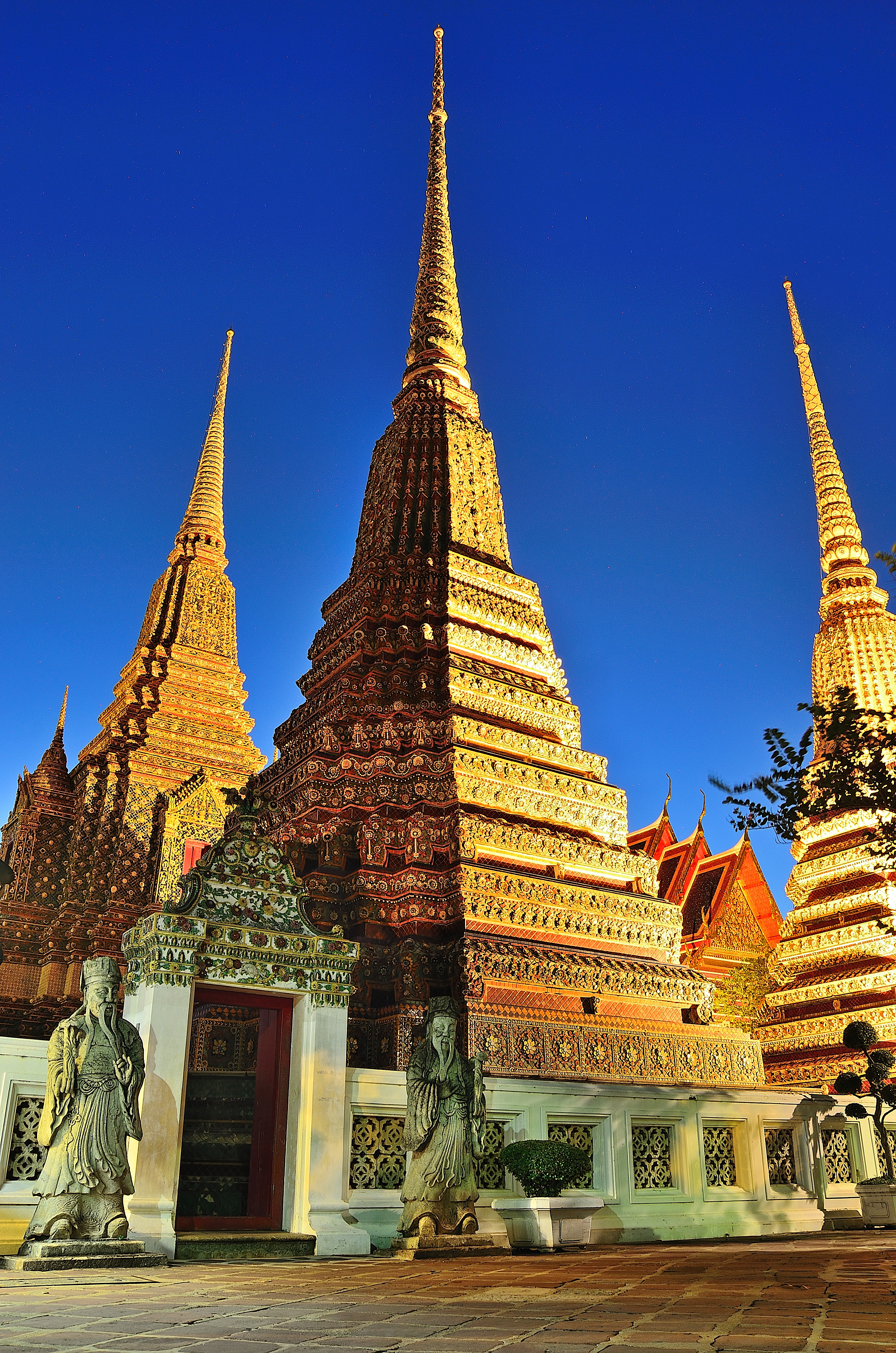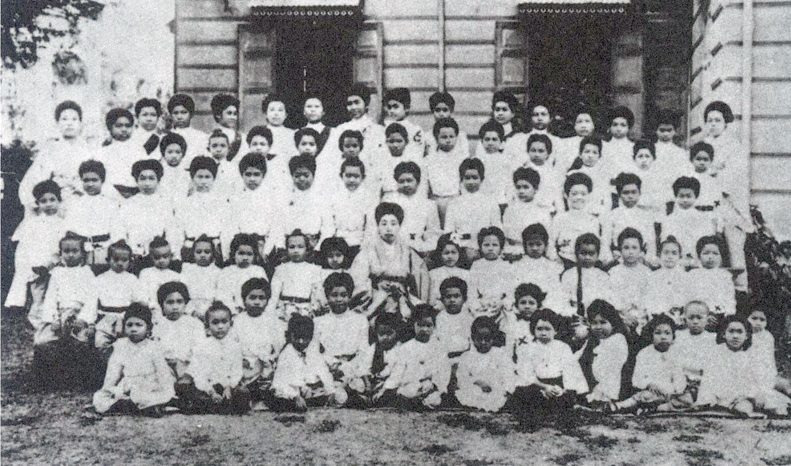|
Wichai Prasit Fort
The fortifications of Bangkok consist of several series of defensive structures built to protect the city during the late Ayutthaya to early Rattanakosin periods. The earliest structures were built when Bangkok was an outpost of Ayutthaya guarding entry to the Chao Phraya River during the 15th–16th centuries. These were reinforced when the city became the site of the short-lived capital of Thonburi after the fall of Ayutthaya in 1767. New walls and forts were built when the city of Rattanakosin replaced Thonburi in 1782, which were mostly removed and replaced in the second half of the 19th century in order to accommodate the expanding city. Today, four of the city's defensive forts remain, along with two short sections of the Rattanakosin city wall and one of the city gates. History Ayutthaya and Thonburi As an important outpost guarding the Chao Phraya, Bangkok (then located on the west bank of the river) was protected by city walls. A pair of forts were located at the confl ... [...More Info...] [...Related Items...] OR: [Wikipedia] [Google] [Baidu] |
Thonburi Royal Palace
Thonburi Palace, also known in Thai as Phra Racha Wang Derm ( th, พระราชวังเดิม, , literally ''former palace''), is the former royal palace of King Taksin, who ruled the Siamese ( Thai) kingdom of Thonburi following the fall of Ayutthaya in 1767 and up until the establishment of Rattanakosin in 1782. It later served as the residence of several high-ranking members of the Chakri dynasty until 1900 when the palace became the site of the Royal Thai Naval Academy. The palace is now within the grounds of the Royal Thai Navy headquarters in Bangkok, and is open for group visits pending advance appointment. History Following the fall of Ayutthaya in 1767 and subsequent Burmese withdrawal, the military leader Phraya Tak succeeded in reclaiming the cities of Ayutthaya and Thonburi (also known as Bangkok). He then established himself as king (later known as Taksin) and made Thonburi his new capital. He had a royal palace built within the old city walls, near th ... [...More Info...] [...Related Items...] OR: [Wikipedia] [Google] [Baidu] |
Tha Phra Chan
Tha Phra Chan ( th, ท่าพระจันทร์, ) is a pier on Rattanakosin Island, Bangkok, on the east bank of the Chao Phraya River, in Phra Nakhon District. The pier is beside Thammasat University's campus of the same name. ''Tha Phra Chan'' literally means 'moon pier' (''tha'', 'pier' or 'jetty', ''phra chan'', 'moon'). More broadly, the name also refers to the area around the pier and the university. The area is also known as a marketplace for Thai amulets and astrologers. It is also full of shops, book stores, restaurants, and food stalls. Tha Phra Chan today used to be the palace of Prince Prachaksinlapakhom (founder of Udon Thani Province) who dedicated the land to the privy purse. Later the area was rented by a ferry company. Its name is derived from ''Fort Phra Chan'' (ป้อมพระจันทร์), one of 14 fortifications around the Grand Palace dating to the early Rattanakosin period. These forts and moats were built to protect Bangkok (or ... [...More Info...] [...Related Items...] OR: [Wikipedia] [Google] [Baidu] |
Wat Pho
Wat Pho ( th, วัดโพธิ์, ), also spelled Wat Po, is a Buddhism, Buddhist temple complex in the Phra Nakhon, Phra Nakhon District, Bangkok, Thailand. It is on Rattanakosin Island, directly south of the Grand Palace, Bangkok, Grand Palace. Known also as the Temple of the Reclining Buddha, its official name is Wat Phra Chetuphon Wimon Mangkhalaram Rajwaramahawihan ( th, วัดพระเชตุพนวิมลมังคลารามราชวรมหาวิหาร; ). The more commonly known name, Wat Pho, is a contraction of its older name, ''Wat Photaram'' (; ). The temple is first on the list of six temples in Thailand classed as the highest grade of the first-class royal temples. It is associated with King Rama I who rebuilt the temple complex on an earlier temple site. It became his main temple and is where some of his ashes are enshrined. The temple was later expanded and extensively renovated by Rama III. The temple complex houses the largest ... [...More Info...] [...Related Items...] OR: [Wikipedia] [Google] [Baidu] |
Rajini School
Rajini School ( th, โรงเรียนราชินี, , lit. "Queen's School") is a private girls' school in Thailand, and one of the oldest in the country. It was founded in 1904 by Queen Saovabha Phongsri as a replacement for the recently closed Sunanthalai School, which she had previously also sponsored. The school is situated in Bangkok's Phra Nakhon District, at the southern tip of the historic inner Rattanakosin Island. Today it admits kindergarten to upper secondary students, with an enrolment of 2,861 in 2019, and is known for its traditional values. The historic Sunanthalai Building is a listed ancient monument. History During the late nineteenth century, Thailand, then known as Siam, was undergoing rapid modernisation of its education system. Schools were established by Western missionaries as well as the government of King Chulalongkorn (Rama V). However, the King's focus was mostly on male education, and the creation of schools for girls lagged considerably ... [...More Info...] [...Related Items...] OR: [Wikipedia] [Google] [Baidu] |
Pak Khlong Talat
Pak Khlong Talat ( th, ปากคลองตลาด, ;) is a market in Wang Burapha Phirom Subdistrict, Phra Nakhon District, Bangkok, Thailand, that sells flowers, fruits, and vegetables. It is the primary flower market of Bangkok and has been cited as a "place of symbolic value" to Bangkok residents. It is on Chak Phet Road and adjacent side-streets, close to Memorial Bridge. Though the market is open 24 hours, it is busiest before dawn, when boats and trucks arrive with flowers from nearby provinces. Its location by Chao Phraya River near the southern end of Khlong Lot, hence the name 'Pak Khlong Talat', literally means "the market on the mouth of the canal". History During the reign of Rama I (1782–1809), the site was a floating market. By the reign of Rama V (1868–1910), it had become a fish market. [...More Info...] [...Related Items...] OR: [Wikipedia] [Google] [Baidu] |
Chak Phet Road
Chak Phet Road at front of Gurdwara Sri Guru Singh Sabha. Chak Phet Road ( th, ถนนจักรเพชร, ; sometimes spelled Chakkraphet or Chakphet) is a road in Wang Burapha Phirom Subdistrict, Phra Nakhon District, Bangkok, with a total length of 1,120 m (3,674 ft). Its name after a fort was called "Pom Chak Phet", southernmost of Rattanakosin Island at mouth of canal Khlong Rop Krung near the foot of Memorial Bridge in present day. It was one of 14 fortifications built to protect the capital from the early Rattanakosin period in the reign of King Phutthayotfa Chulalok (Rama I). Later, in the reign of King Chulalongkorn (Rama V), when the capital grew more. These fortifications were demolished. Chak Phet Road began to be built on 28 September 1898, divided into two phases: the first phase, from Pom Chak Phet beside Wat Ratchaburana to Pak Khlong Talat, and the second phase from Pom Chak Phet to the intersection of Yaowarat, Maha Chai, Phiraphong Roads near Pom ... [...More Info...] [...Related Items...] OR: [Wikipedia] [Google] [Baidu] |
Damrong Sathit Bridge
file:สะพานดำรงสถิต970.jpg , 250px, Saphan Lek or Damrong Sathit Bridge in 2014 Saphan Lek ( th, สะพานเหล็ก, , ) is the name of a bridge and a now-extinct makeshift market near the bridge in Bangkok. Now officially known as Damrong Sathit Bridge (, ), the bridge was originally built to carry the Charoen Krung Road across Khlong Ong Ang during 1862–1864. It had a steel structure supporting a wooden floor, with an opening mechanism that allowed boats to pass. The bridge was rebuilt in 1900 under the supervision of Carlo Allegri, and named Damrong Sathit in honour of Prince Damrong Rajanubhab. It was yet again rebuilt with reinforced concrete in the reign of King Prajadhipok (Rama VII, 1925–1935), and is now a recognised ancient monument (Thailand), ancient monument. In the 1980s, the canal-side area south of the bridge became the site of a makeshift market selling video games, electronics and toys. Illegal structures were built that encr ... [...More Info...] [...Related Items...] OR: [Wikipedia] [Google] [Baidu] |
Old Bangkok Remand Prison
The Bangkok Corrections Museum is an incarceration museum in Bangkok, Thailand. It is located on Maha Chai Road. It was planned to follow the Brixton Prison of England. The prison museum was established in 1939 in another prison, the Bang Kwang Central Prison, which had served as a training center for corrections officers and gained the notorious title " Bangkok Hilton" in the way that the Hanoi Hilton did in Vietnam for its brutal prison history. The museum records the macabre history and prison life in Thailand. Later the remainder of the site became the Rommaninat Park, officially opening on August 7, 1999, by Prince Maha Vajiralongkorn. The museum is closed for the foreseeable future. Display On the upper floor are life-sized waxed figures involved in execution scenes, depicting gruesome scenes with swords and torture. The second and third blocks of the Bangkok Corrections Museum contrastingly exhibit the finest items made by the prison inmates during their imprisonment ... [...More Info...] [...Related Items...] OR: [Wikipedia] [Google] [Baidu] |
Chaloem Wan Chat Bridge
Chaloem Wat Chat Bridge ( th, สะพานเฉลิมวันชาติ, , ; ; sometimes shortened to ''Saphan Wan Chat'') is a bridge and four-way intersection in the area of Bang Lamphu, Bowon Niwet and Ban Phan Thom sub-districts, Phra Nakhon district, Bangkok. It's not far from Khao San and Rambuttri roads. Chaloem Wan Chat Bridge is a bridge across Khlong Rop Krung (''around the city canal'') or popularly known as Khlong Bang Lamphu on Prachathipatai road, considered as the beginning point of Prachathipatai road and the tip of Dinso road. The bridge was built in 1940 in the era of government of Field Marshal Plaek Phibunsongkhram to celebrate the national day of Thailand. At that time, falls on December 10, which is a memorial day at the King Prajadhipok (Rama VII) gave a first permanent constitution. Nowadays, Thailand's national day is December 5, the birthday of King Bhumibol (Rama IX) and December 10 became the Constitution Day. Around the bridge is well ... [...More Info...] [...Related Items...] OR: [Wikipedia] [Google] [Baidu] |
Phan Fa Lilat Bridge
Phan Fa Lilat Bridge ( th, สะพานผ่านฟ้าลีลาศ, , ; lit: 'bridge on which the ruler of heaven proceeds', refers to "King's Cross Bridge"; usually shortened to "Phan Fa Bridge") is a historic bridge across Khlong Bang Lamphu (Bang Lamphu canal) on Ratchadamnoen Avenue on the border of Ban Phan Thom and Bowon Niwet sub-districts, Phra Nakhon District with Ban Bat sub-district, Pom Prap Sattru Phai District, inner Bangkok near Mahakan Fort, Queen Sirikit Gallery and King Prajadhipok Museum. It divides Ratchadamnoen Avenue into two parts: Ratchadamnoen Klang (ราชดำเนินกลาง; 'Central Ratchadamnoen') and Ratchadamnoen Nok (ราชดำเนินนอก; 'Outer Ratchadamnoen'), considered to be a pair with a Phan Phiphop Lila Bridge (สะพานผ่านพิภพลีลา), it is on Ratchadamnoen Nai (ราชดำเนินใน; Inner Ratchadamnoen) near the Royal Rattanakosin Hotel beside Sanam Luang. ... [...More Info...] [...Related Items...] OR: [Wikipedia] [Google] [Baidu] |
Wat Bowonniwet
Wat Pavaranivesh Vihara Ratchawarawihan ( th, วัดบวรนิเวศวิหารราชวรวิหาร; , ) is a major Buddhist temple (''wat'') in Phra Nakhon district, Bangkok, Thailand. Being the residence of Nyanasamvara Suvaddhana; the late Supreme Patriarch of Thailand, it is the final resting place of two former kings of Chakri Dynasty; King Vajiravudh (Rama VI) and King Bhumibol Adulyadej (Rama IX). The temple was established in 1824 by Mahasakti Pol Sep, viceroy during the reign of King Rama III (r. 1824–51). The temple is a center of the Thammayut Nikaya order of Thai Theravada Buddhism, it is the shrine-hall of ''Phra Phuttha Chinnasi'' (พระพุทธชินสีห์), a statue of the Buddha which dates to around 1357. Bowonniwet has been a major temple of patronage for the ruling Chakri dynasty.Liedtke 2011, p. 57 It is where many royal princes and kings studied and served their monkhood, including King BhumibolMacdonald 2009 ... [...More Info...] [...Related Items...] OR: [Wikipedia] [Google] [Baidu] |
.jpg)
.jpg)




